Gupta Architecture › Gwanggaeto the Great » Ancient origins
Articles and Definitions › Contents
- Gupta Architecture › Antique Origins
- Gwanggaeto the Great › Who Was
Ancient civilizations › Historical and archaeological sites
Gupta Architecture › Antique Origins
Definition and Origins
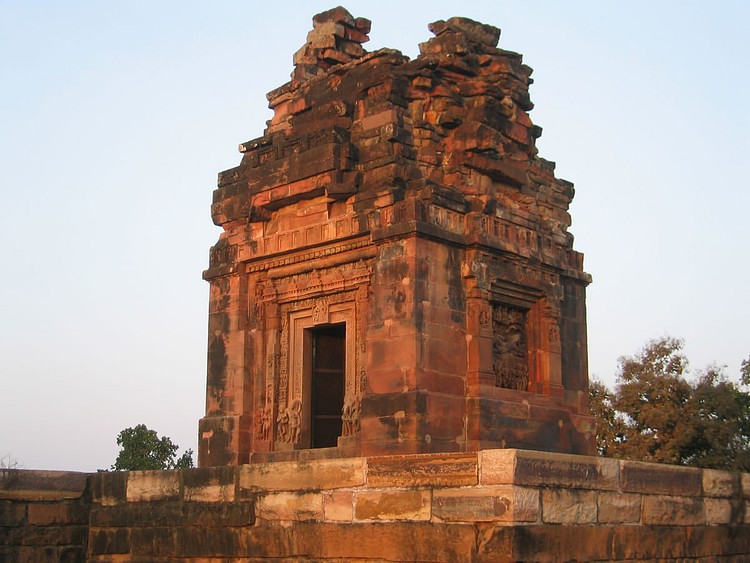
The Gupta Dynasty, founded by Chandragupta I (accession c. 320 CE), ruled in North Central India between the 4th and 6th centuries CE and the period is considered a golden age of artistic accomplishment. The Guptas were the first architects of purpose-built Hindu (but sometimes also Buddhist ) temples which evolved from the earlier tradition of rock-cut shrines.Adorned with towers and elaborate carvings, these temples were often dedicated to all the Hindu gods. Unfortunately, relatively few of the large number of Gupta temples built have survived.
Gupta architecture is very diverse in style, design and features. This very diversity illustrates that Hindu temple architecture was in its formative stage and was yet to arrrive at the standardised situation of later centuries. Nevertheless, the influence of Gupta-era buildings on later Indian temple architecture is indisputable and continued right through to the Medieval period.
GUPTA CAVE SHRINES
The earliest examples of religious architecture were cave-temples which typically had exteriors decorated with relief sculpture and a single carved doorway. Inside the shrine, ritual sculptures were placed such as a Shiva linga (phallus) and the walls were richly decorated with more carvings showing scenes from mythology. Notable examples are found at Udayagiri in Madhya Pradesh where one cave bears a date mark of 401 CE. Here in one shrine is one of the finest examples of Gupta art, the celebrated relief showing Vishnu in his incarnation as the boar-headed Varaha. The panel measures 7 x 4 metres and the central figure, carved almost in the round, is emerging from the cosmic waters, having defeated a snake-like monster and rescued the goddess Bhudevi (Earth). The scene, a famous Hindu myth, may also be an allegorical reference to the peace and protection offered by the Gupta kings.
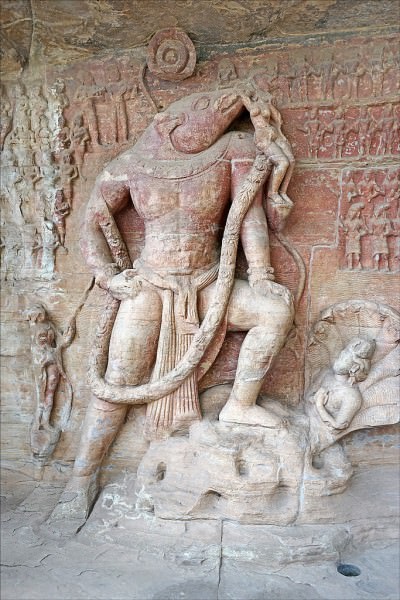
Vishnu as Varaha, Udayagiri Caves
Finally, mention should be made of the Ajanta caves, a row of 29 rock-cut caves following the Waghora river bed ravine in north-west Deccan. Dating from the 2nd century BCE to 7th century CE, they contain some of the earliest and finest examples of Indian wall -painting. The subject matter is largely scenes from the life of Buddha. Cave 1 contains a columned shrine in typical Gupta style with flat cushion-topped column capitals. Cave 19 was built in the 5th century CE and has a Gupta-style chaitya (shrine) facade with columned porch and large, almost semi-circular aperture above. The whole facade is covered in rich carvings and relief panels showing scenes from Buddhist lore.
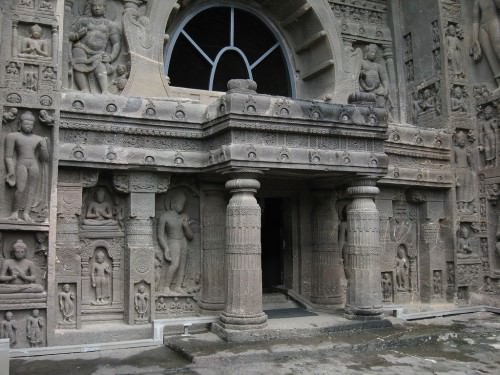
Cave 19, Ajanta, Deccan
GUPTA TEMPLES: MATERIALS & FEATURES
Not satisfied with caves the Guptas were the first dynasty to build permanent free-standing Hindu temples and so they began a long tradition of Indian temple architecture. It is perhaps important to note here that Hindu temples were not designed for congregations but rather as the dwelling place ( devalaya ) of a deity. This decorated palace ( prasada ) allowed priests to give offerings to the gods and individuals could also offer prayers, flowers, and food ( puja ), usually to a sacred relic or statue representing a particular god which was housed in a relatively small and windowless architectural space (the garbhagriha ).Believers would also walk around the temple in a ritual act of worship.
IN GUPTA ARCHITECTURE THE SQUARE WAS CONSIDERED THE MOST PERFECT FORM AND TEMPLES WERE DESIGNED TO BE APPRECIATED FROM ALL SIDES.
The Gupta style was influenced by Kusana, Mathura, and Gandhara and borrowed the common features of T-shaped doorways, decorated door jambs, sculpted panels with high-relief figures, and laurel-wreath and acanthus motifs. Constructed using sandstone, granite, and brick, Gupta-era temples added to this architectural heritage with horseshoe gavakshas arches and distinctive curved shikhara towers which are frequently topped with a ribbed disk ornamentation known as an amalaka.These elaborate buildings are further decorated with a mass of ornate mouldings and sculptures set in niches. In Gupta architecture, the square was considered the most perfect form and temples were designed to be appreciated from all sides so that each carries decorative architectural features.
Most temples also adopt a square plan with the single cubicle garbhagriha in the centre. This is normally entered by a short columned porch set over a single, highly decorated doorway with a projecting lintel. Columns can support a pot-and-foliage capital, and roofs were generally flat, as in surviving examples at Tigawa and Sanchi in Madhya Pradesh. Other typical Gupta decorative features include triangle motifs inside doorways and lion's heads at the ends of stone beams.
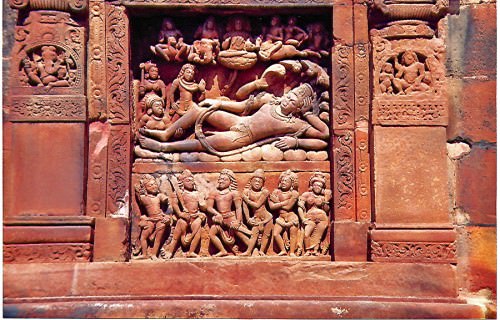
Vishnu Anantasayana Panel, Dashavatara Temple, Deogarh
Whether all temples had a second floor is difficult to determine, due to their often ruinous condition. The late 5th century CE Parvati temple at Nachna Kuthara is notable for its surviving second-story shrine room. From the 6th century CE, Gupta temples were built on a platform ( jagati ) and a good example is the Dashavatara temple at Deogarh in Madhya Pradesh. At Deogarh the platform had reliefs running around it depicting scenes from the Ramayana epic poem. In the centre of the jagatistood the principal shrine, which was without windows and accessed by a flight of steps on all four sides. Four lesser shrines stand at each corner of the complex.
Typical of the period in general, Gupta temples were dedicated to a large number of Hindu gods rather than a single deity.Accordingly, architectural sculpture represents a wide range of gods in scenes from Hindu mythology. The doorway to the square sanctuary tower of the Dashavatara temple is a fine example and carries sculpture of Vishnu, Brahma, Indra, Ganga, and Yamuna, as well as attendants and mithuna couples. The temple also carries one of the most famous sculptural panels from ancient India, the Vishnu Anantasayana panel. The scene contains many gods but is dominated by a sleeping Vishnu who rests on the multi-headed serpent Ananta and floats on the waters of oblivion whilst from his navel sprouts a lotus leaf on which sits Brahma, the god of creation.
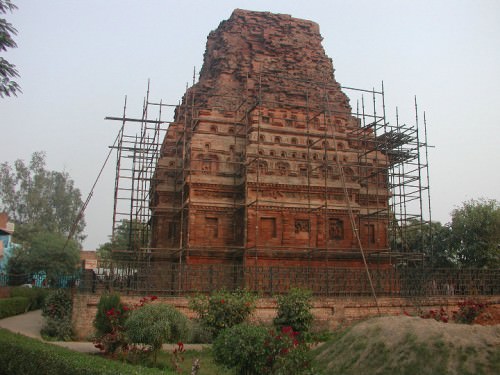
Bhitargaon
BHITARGAON
The temple at Bhitargaon in Uttar Pradesh is one of the most complete surviving Gupta temples. It is a rare early example of a Hindu temple constructed entirely of brick, dating to the late 5th century CE. Although damaged in its upper portion, the four-sided and curved shikhara tower of the temple maintains its gavaksha niches and shallow pilasters which diminish in size as the tower rises to a pinnacle. These and the decorated capitals create frames in which were once set terracotta panels.
Few panels survive intact but examples from other sites demonstrate that they would have once shown lively scenes from mythology, in particular figures of river goddesses. Panels still in their original position in the upper tiers of the tower display grotesque faces which remind of the gargoyles of European Gothic cathedrals (Harle, 115).
Gwanggaeto the Great › Who Was
Definition and Origins
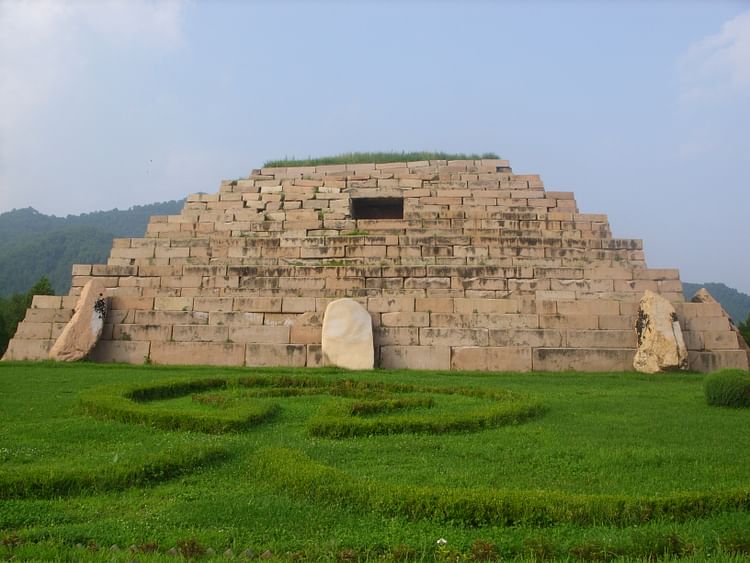
Gwanggaeto (Kwanggaeto), often referred to as Gwanggaeto the Great, was king of the Goguryeo ( Koguryo ) kingdom which ruled northern Korea during the Three Kingdoms period. Gwanggaeto reigned between 391 and 413 CE, and living up to his other title of 'broad expander of domain,' he extended the kingdom to its greatest extent and presided over the period of its greatest prosperity. His lasting reputation as one of Korea's finest leaders and field commanders is largely due to a lengthy inscribed stele set up outside his massive tomb at the then Goguryeo capital of Kungnaesong.
GOGURYEO'S GOLDEN PERIOD
The Goguryeo kingdom ruled from 37 BCE to 668 CE and was the largest of the Three kingdoms of ancient Korea. It was not until the 4th century CE that the state displayed a fully centralised government and control of its territory. Then the early 5th century CE saw the beginning of Goguryeo's greatest period during the reign of Gwanggaeto. A solid political foundation at home allied with pragmatic foreign relations with Goguryeo's neighbours Baekje ( Paekche ) and Silla went hand-in-hand with an aggressive expansionist policy towards northern tribes and the southern states of China. At the same time, friendly relations were maintained with China's northern states. The result of this mix of militarism and diplomacy was that Gwanggaeto was eventually able to dominate northern Korea, most of Manchuria, and a portion of Inner Mongolia. Goguryeo itself also benefitted from this prosperity with Gwanggaeto building nine new Buddhist temples at Pyongyang alone. So successful was this period that Gwanggaeto even coined a new term for it: Yongnak or 'Eternal Rejoicing.'
SO SUCCESSFUL WAS GWANGGAETO'S REIGN THAT HE EVEN COINED A NEW TERM FOR IT: YONGNAK OR 'ETERNAL REJOICING.'
GWANGGAETO'S STELE
Much of what is known of the history of this period derives from the 12th-century CE Samguk sagi text ('Historical Records of the Three States') and a 7.3 metre tall stele erected outside Gwanggaeto's tomb by his son Changsu in 414 CE. The engraved stone recounts the king's exploits in 1,800 Chinese seal script characters. The stele is the earliest known inscription from ancient Korea and is an extraordinary historical record of the major events of Gwanggaetto's reign. The text begins by describing the foundation of Goguryeo by the legendary Chumong. There is then a quote from the Confucian classic text Shujing and a reference to the king by the Chinese reign title Yongnak. The latter is significant as it gives Gwanggaetto equal status to the Chinese emperor, who was the only other person permitted a reign title.
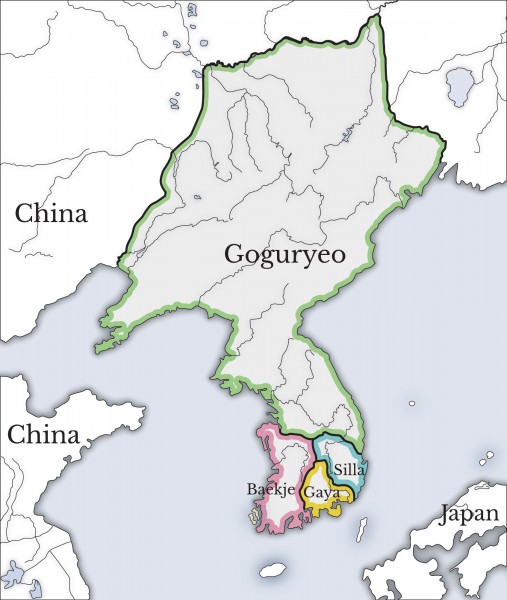
Three Kingdoms of Korea
The text goes on to describe Gwanggaeto's accession to the throne when he was 19 years old, and then there is a long list of his military exploits. Reforming the armed forces of Goguryeo into separate naval, army, and cavalry units, the king assumed a position at the head of a centralised chain of command and led his men personally in the field. There were also developments at this time in metal forging so that Goguryeo warriors had superior steel weapons. With an armoured cavalry unit, he occupied the Liaodong fortress in south-eastern Manchuria, conquered the northern Murong, Sushen (Sukchin) and Yilou tribes, and captured areas of the rival Baekje kingdom to the south-west in 396 CE including briefly the capital Hansong, the Gwanmiseong fortress, and the strategically important Han River basin. The Baekje king Asin now took his orders from Gwanggaeto.
With Gwanggaeto's military support of 50,000 men, the Silla kingdom was able to successfully repel a Japanese Wa and Baekje invasion force in 400 CE. Indeed, the kingdom of Silla under the reign of Namul became a vassal of Goguryeo. Also in 400 CE Goguryeo and Silla again joined forces, this time to attack the small Gaya ( Kaya ) confederation in the far south of the peninsula. This alliance between Goguryeo and Silla may explain the presence of a lidded bronze bowl inscribed with Gwanggaeto's name which was discovered in a tomb at the Silla capital of Gyeongju (Kyongju). In effect, Goguryeo, albeit loosely, now controlled most of Korea.
In 406 CE a peace treaty was signed with the Murong Later Yan state in which Goguryeo was obliged to give military help against the Tuoba Northern Wei state of China in return for territorial gains. Near the end of his reign in 410 CE most of Manchuria and the neighbouring east coast area known as the Maritime Province of Russia were under Goguryeo control. The stele also states that the king conquered no fewer than 64 fortified towns and 1,400 villages so that when he died Goguryeo controlled two-thirds of the Korean peninsula and a large swathe of Manchuria.

Gwanggaeto Stele
The stele is not without some controversy. It disappeared for centuries only turning up again in the 1880s CE when, fortunately, a rubbing was taken of the text by a Japanese soldier. The portion of the stele text which describes Gwanggaeto's victory over the Japanese was vandalised during the Japanese occupation in the 20th century CE. Japanese historians maintain that the stele corroborates the theory that Japan had a colony in south-east Korea from 365 to 561 CE, but this is controversial.
DEATH & TOMB
Gwanggaeto died in 413 CE and was succeeded by his son Changsu who, incredibly, reigned until 491 CE, earning him the deserved title of 'long-lived.' He continued his father's work, moved the capital from Kungnaesong to Pyongyang in 427 CE and ensured the continued prosperity of Goguryeo.
From the 4th century CE, Goguryeo kings were buried in tombs constructed of cut-stone blocks placed within large earth mounds. The largest example of such a tomb is at the former capital Kungnaesong (modern Tonggou/Tungkou) and thought to be that of Gwanggaeto. It is also known as the Tomb of the General. 75 metres long and using blocks measuring up to 3 x 5 metres, it has four smaller dolmen -like structures at each corner. The stele which proclaims the great king's deeds stands just outside it.
This article was made possible with generous support from the British Korean Society.
LICENSE:
Article based on information obtained from these sources:with permission from the Website Ancient History Encyclopedia
Content is available under License Creative Commons: Attribution-NonCommercial-ShareAlike 3.0 Unported. CC-BY-NC-SA License